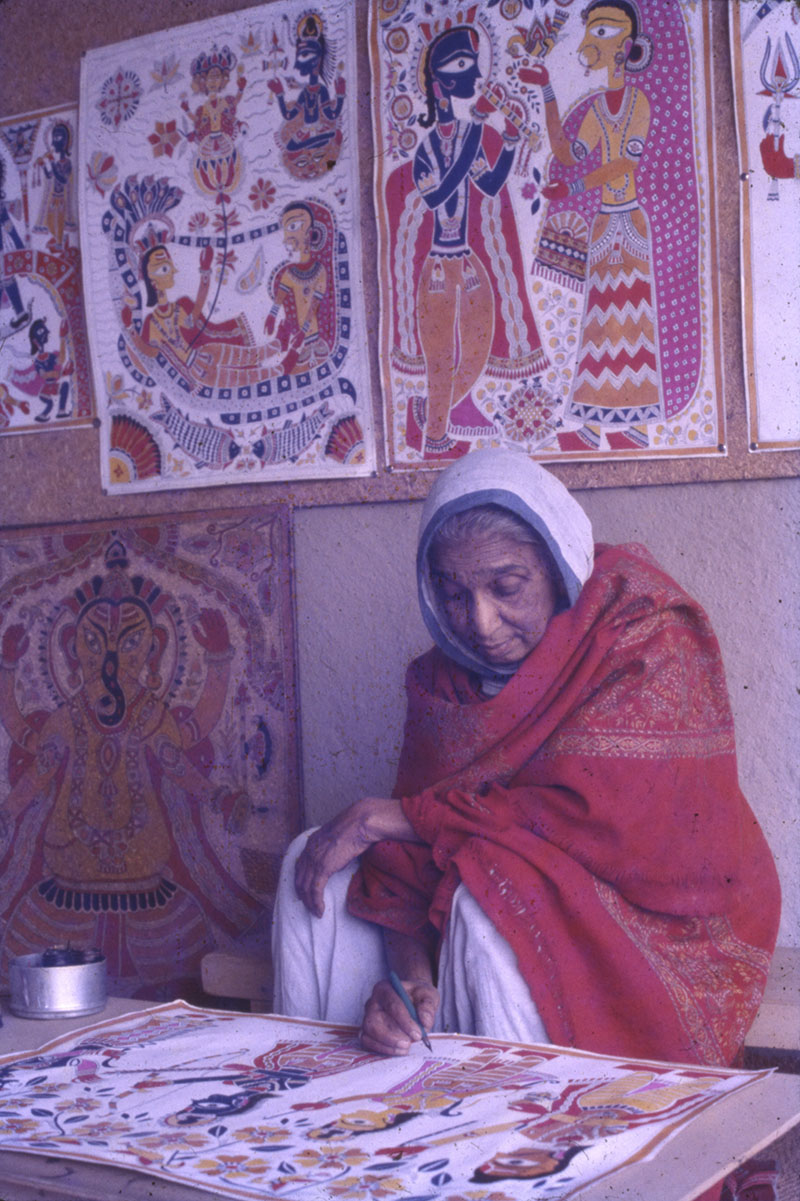Considered a pioneer artist of Madhubani painting, Sita Devi’s work and career brought attention to the artform and led to its formal adaptation outside the scope of tradition. Devi was born to a Mahapatra Brahmin family and moved to the village of Jitwarpur village near Madhubani upon her marriage.
Among the first artists of Mithila who started painting on paper and canvas, Devi popularised the bharni style of Madhubani painting wherein spaces were filled with colour instead of lines. Traditionally, paintings in kachini style using one or two colours and only linework were commonly rendered by Kayastha women, and bharni by Brahmins. Her paintings drew from cultural and mythological themes such as the images of Krishna, Radha and other deities. Besides this, Devi also went on to paint aspects of contemporary life and the world from her travels such as the World Trade Centre and the Arlington National Cemetery. One of her best known works is her painting of Krishna – painted in the 1970s on board instead of paper – in which he is flanked by two attendants and finely embellished with flowers and peacocks at his feet.
In addition to her artistic practice, Devi also worked towards the upliftment of her village. Her fame and lobbying efforts were successful in developing roadways, education centers and economic avenues for the residents of Jitwarpur.
During Devi’s career, her work was exhibited and recognised nationally and internationally. She was an artist-in-residence at the National Crafts Museum & Hastkala Academy, New Delhi and was awarded a National Award in 1975, a Padma Shri in 1981 and Silpa Guru in 2006 by the government of India. In 1984, the government of Bihar awarded her with the Bihar Ratna Samman. Her work has been widely collected and is part of private and public collections in Victoria and Albert Museum (V&A), London; the Los Angeles County Museum of Art; the Philadelphia Museum of Art; Musée du Quai Branly, Paris; and Mithila Museum, Tokamachi.
She passed away in 2005, at the age of 92, in Madhubani, Bihar.






![The façade of the Maneckji Seth Agiary, a Zoroastrian fire temple, is a standout example of the popularity of the Persian Revival Style in Western India in the 19th and 20th centuries. This style was often seen in the architectural patronage of the Parsis, who emerged as one of the most influential mercantile communities of British India. Popular motifs of this style, like the mythical lamasus (winged bulls with human heads) and the faravahar (a winged guardian spirit in Zoroastrianism), drew on the historical art and architecture of the Achaemenid and Sasanian empires from sites like Persepolis, Bisotun, Taq-e Bostan, Naqsh-e Rostam and Naqsh-e Rajab in Persia.
The Parsi community’s adoption of this style occurred largely due to their networks of global commerce and politics, allowing them to access and translate research of ancient Persia into visible symbols that underlined their association with antiquity, imperial power, and art.
نمای آتشکدهی زرتشتی مانِکجی سِت نمونهی بارزی از رواج سبک «احیای [معماری] ایرانی» در غرب هند طی سدههای نوزدهم و بیستم است. این سبک غالباً در بناهایی دیده میشد که پارسیان، از بانفوذترین جوامع بازرگان در هند بریتانیا، بانیشان بودند. نقشمایههای محبوب این سبک، مانند گاو بالدار اساطیری (لاماسو) و فَروَهَر (روح بالدار نگهبان در دین زرتشت)، برگرفته از هنر و معماری شاهنشاهی هخامنشی و ساسانی، در جاهایی چون تخت جمشید و بیستون و طاق بستان و نقش رستم و نقش رجب، بود.
اقتباس جامعهی پارسیان از این سبک بسیار مرهون روابط گستردهی تجاری و سیاسی آنها بود که دسترس به پژوهشها دربارهی ایران باستان و برگردانیدن آنها به نمادهای بصری را ممکن میکرد و بر پیوند پارسیان با دوران باستان و قدرت شاهنشاهی و هنر تأکید میکرد.](https://mapacademy.io/wp-content/plugins/instagram-feed/img/placeholder.png)
